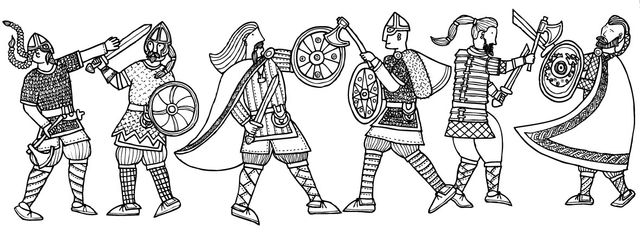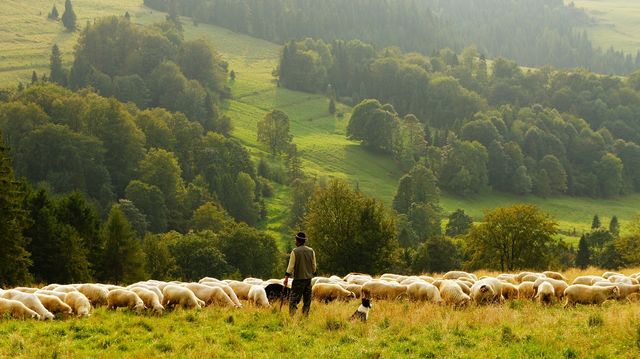3.6.1
Old English
The Celts
The Celts
To track the way English changes, we’re going to look chronologically at what happened from 400 AD to modern day. Old English refers to the period from about 400 AD to 1100.


British history
British history
- To track the way English changes, we’re going to look chronologically at what happened from 400 AD to modern day.
- Pre-5th century, there were a tribe of people living in Britain called the Celts.
- Around 455, there was an invasion of Britain.


First invasion
First invasion
- Who invaded?
- The Angles, The Saxons and The Jutes
- When?
- Around 455.
- Who or what was impacted?
- The Celts and their language (Celtic).


The Celts
The Celts
- The Celts (and their language) were pushed to the very edges of the country (Scotland, Wales, Cornwall etc).
- However, we can still see the influence they had in:
- Place names (like Carlisle).
- Dialectal words (like crag).
- River names (like the Thames).


Celtic morphemes
Celtic morphemes
- In addition, the ‘-ing’, ‘-ton’ and ‘-ham’ suffixes denote the Celtic morphemes for ‘the people of’, ‘enclosure or village’ and ‘farm’ respectively.
The Anglo-Saxons
The Anglo-Saxons
The Angles and the Saxons (the Anglo-Saxons) became dominant in England, replacing Celtic with their own language (which came to be called ‘Old English’ or ‘Englisc’).


The Anglo-Saxons
The Anglo-Saxons
- The Angles and the Saxons (the Anglo-Saxons) became dominant in England, replacing Celtic with their own language (which came to be called ‘Old English’ or ‘Englisc’).
- Old English had a lexicon of around 25,000 words and was very much an aural language: the written work was meant to be read aloud.


Divisions
Divisions
- The country then became divided into four main sections:
- Mercian.
- Northumbrian.
- Kentish.
- West Saxon.
- All of which spoke varieties of Old English.


Examples of Old English
Examples of Old English
- The following are some examples of Old English you can use in your exam:
- Nouns: Son, daughter, youth, field, friend, home and ground.
- Verbs: Drink, come, go, sing, like and love.
- Preposition: In, on, into, by and from.


The Danish language
The Danish language
- Following this, in the 9th century, the Danish language spread around the country leading to a simplified grammatical system in Old English.
- Also around this time, borders came into place, preventing travel.


Old Norse
Old Norse
- However, trade was permitted.
- This led to the borrowing and trading of words.
- Some examples of words from Old Norse are:
- Score, sky, skive, anger, ball, freckle, neck, root, skull and window.
1Language Levels
1.1Assessment Objectives
1.2Lexis
1.2.1Introduction
1.2.2Common, Proper, Abstract & Concrete Nouns
1.2.3Collective Nouns
1.2.4Adjectives
1.2.5Main, Auxiliary & Copular Verbs
1.2.6Dynamic & Stative Verbs
1.2.7Transitive, Intransitive, Active & Passive Verbs
1.2.8Mood of Verbs
1.2.9Adverbs
1.2.10Personal, Possessive & Reflexive Pronouns
1.2.11Relative & Demonstrative Pronouns
1.2.12Determiners
1.2.13Conjunctions
1.2.14Synonyms, Antonyms & Phonological Features
1.2.15End of Topic Test - Lexis
1.3Grammar
1.4Semantics & Pragmatics
1.5Discourse Structure, Graphology & Orthography
2Language, The Individual & Society
2.1Children’s Language Development
2.2Children's Language Development - Theories
2.3Literacy Development: Reading
3Language Diversity & Change
3.1The Importance of Gendered Language
3.2Social Groups
3.3Occupational Groups
3.4Accents & Dialects
3.5Language Change
Jump to other topics
1Language Levels
1.1Assessment Objectives
1.2Lexis
1.2.1Introduction
1.2.2Common, Proper, Abstract & Concrete Nouns
1.2.3Collective Nouns
1.2.4Adjectives
1.2.5Main, Auxiliary & Copular Verbs
1.2.6Dynamic & Stative Verbs
1.2.7Transitive, Intransitive, Active & Passive Verbs
1.2.8Mood of Verbs
1.2.9Adverbs
1.2.10Personal, Possessive & Reflexive Pronouns
1.2.11Relative & Demonstrative Pronouns
1.2.12Determiners
1.2.13Conjunctions
1.2.14Synonyms, Antonyms & Phonological Features
1.2.15End of Topic Test - Lexis
1.3Grammar
1.4Semantics & Pragmatics
1.5Discourse Structure, Graphology & Orthography
2Language, The Individual & Society
2.1Children’s Language Development
2.2Children's Language Development - Theories
2.3Literacy Development: Reading
3Language Diversity & Change
3.1The Importance of Gendered Language
3.2Social Groups
3.3Occupational Groups
3.4Accents & Dialects
3.5Language Change
Unlock your full potential with Seneca Premium
Unlimited access to 10,000+ open-ended exam questions
Mini-mock exams based on your study history
Unlock 800+ premium courses & e-books